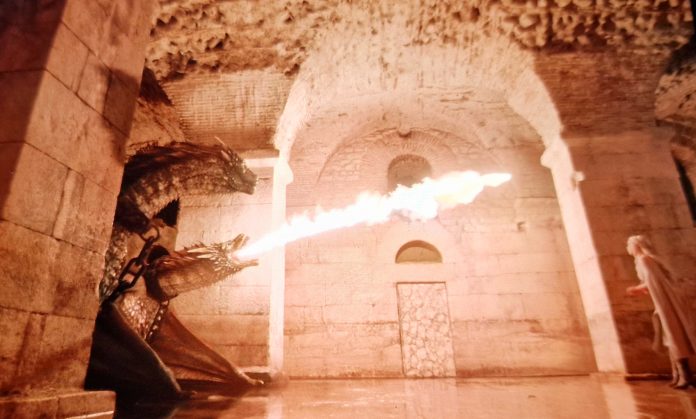There are places in the world where fiction borrows from history. And then there is Split, where history is so alive, so textured, that fantasy simply steps into it.
When HBO chose the ancient cellars of Diocletian’s Palace as a key filming location for Game of Thrones, it wasn’t just because the stones were old. It was because they were alive — layered with memory, scarred by centuries, and still whispering the ambition of an emperor.
A City Beneath the Palace
In the series, the cellars of the palace became Daenerys Targaryen’s throne room in Meereen, where dragons were chained and rebellion stirred. But long before dragons, this was the foundation of a real empire.
These massive substructures supported Diocletian’s private quarters above and mirrored their layout. Roman engineers designed them to be practical — strong, elevated, watertight. And yet today, they feel mystical: echoing chambers of cold limestone, pillars holding up both past and present.
When film crews arrived, they changed almost nothing. The space didn’t need CGI. It already looked like it belonged to another world. And it worked.
Dragons screeched in chains where Roman aqueducts once ran. Guards walked through shadows once cast by imperial slaves. And Split’s cellars, once forgotten and buried under centuries of debris, became globally iconic.
Dragons and Diocletian
In many ways, the two rulers — Diocletian and Daenerys — are not so different. Both were powerful, divisive, visionary. Both believed in control, in order, in symbols.
Diocletian built a palace on the edge of the empire to watch the sea and retreat into divinity. Daenerys stood in that same palace (albeit as fiction), trying to tame her dragons and rule through fear and justice. The stone made the transition seamless.
And for viewers who visited after the episodes aired, there was a thrill in discovering that this place wasn’t made for TV. It was made for eternity.
The Unsullied and the Streets of Meereen
Several other scenes were filmed above ground, within the stone alleys and narrow corridors of Diocletian’s Palace itself.
In Season 4, the battle between the Unsullied and the Sons of the Harpy was filmed in the very heart of Split’s palace district. Viewers watched as the disciplined army of Daenerys clashed with masked assassins in brutal, intimate combat. But locals knew these streets well: they walk them every day.
The ancient alleyways where tourists now wander with gelato in hand were, on screen, filled with blood, fire, and vengeance. And when Ser Barristan Selmy, one of Westeros’ most beloved knights, fell in battle during that scene, he died not in a set—but in an alleyway behind a 4th-century temple.
The death of a fictional knight became forever tied to a real place.
A New Wave of Pilgrims
Game of Thrones brought a new kind of traveler to Split: fans. People from around the world who came to stand where scenes were filmed, to walk the same stones as their favorite characters. But often, something deeper happened.
They came for Westeros. They left talking about Rome.
Because once you enter the palace, you feel the weight of real history. You notice the wear on the steps, the ancient drains, the limestone that glows gold at sunset. You hear street musicians playing beneath arches that once heard imperial orders.
You realize: this isn’t a film set. It’s a foundation.
Where Fantasy Meets Legacy
The success of Game of Thrones didn’t rewrite Split’s story. It simply revealed a new chapter.
Tourists now take “Game of Thrones walking tours”, exploring the palace, the basements, nearby Klis Fortress, and even local stone quarries used as filming sites. But the best part? They often leave those tours not only with photos — but with questions:
- Who was Diocletian?
- Why did he choose Split?
- How did this palace survive?
Fantasy, then, becomes a gateway to curiosity. And Split, with its living history, becomes more than a backdrop. It becomes a teacher.
Visiting the Thrones of Two Worlds
If you’re walking Split as a fan of Game of Thrones, don’t just look for dragons. Look for the emperor. Look for the people who lived here, died here, rebuilt it again and again.
Visit the cellars, and notice the stone.
Stand in the Peristyle, and imagine ceremonies not of fire and blood, but of incense and empire.
Climb to Klis Fortress, and realize it wasn’t fantasy — it was resistance, faith, and survival.
In Split, fantasy and reality share the same throne room.
You don’t need special effects. You just need to listen.

